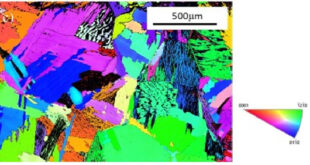Significance Statement
There are many fabrication techniques for micro-channel production including conventional and non-conventional techniques. The processing of Inconel 718 under different machining processes is reviewed in a table representing the advantages and shortfalls of each machining process. This study is related to the fabrication of micro-channels in nickel based aerospace superalloy (Inconel 718) through laser beam machining. The micro-channels of size 100 x 100 µm are realized using nano second Nd:YAG laser under two operating conditions naming dry and wet machining conditions. The effects of laser parameters on geometrical characteristics of micro-channels during both the machining environments are studied. The results are then compared with the employed machining conditions and experienced that the wet medium is more productive than dry medium in terms of geometry and number of micro-channels. The presence of water causes the micro-channel to be subdivided into two micro-channels thus increasing the machining productivity. The appropriate combinations of laser parameters are also proposed to get optimum geometrical dimensions of micro-channels.
Journal Reference
The International Journal of Advanced Manufacturing Technology, pp 1-17, 2015.
Saied Darwish 1,2,3, Naveed Ahmed 1,2,3,4, Abdulrehman M. Alahmari 1,2,3, Nadeem Ahmad Mufti 4
[expand title=”Show Affiliations”]- Industrial Engineering Department, King Saud University, Riyadh – Saudi Arabia.
- Advanced Manufacturing Institute, King Saud University, Riyadh – Saudi Arabia.
- Princess Fatima Alnijiris’s Research Chair for Advanced Manufacturing Technology (FARCAMT), King Saud University, Riyadh – Saudi Arabia.
- Department of Industrial and Manufacturing Engineering, University of Engineering and Technology, Lahore – Pakistan. [/expand]
Abstract
Micro-channels have been fabricated in nickel based superalloy (Inconel 718) through laser beam machining (LBM). Two machining mediums are employed; dry and wet medium. Under the dry medium, laser beam passes through air prior to strike with target surface while under wet medium the laser beam first travels through a layer of distilled water and reaches the substrate after. For both the machining environments, effects of laser power, pulse repetition rate and laser scan speed on machined channels’ width, depth and taperness are investigated. A comparison of parametric effects on machined channels’ profiles has been carried out for the said machining conditions. The results reveal that laser beam machining under distilled water is more productive than laser beam machining under air environment. In one step, wet machining conditions allow to generate a set of two micro-channels and dry conditions generate one micro-channel. Further, to achieve the optimum dimensions of micro-channels the appropriate level of each of the investigated laser parameter is proposed.
Go To The International Journal of Advanced Manufacturing TechnologyFigure Legend
Experimental setup for under-water laser beam machining and the fabricated micro-channels using dry and wet mediums (channels in 1st row are under dry medium and in 2nd row are under wet medium).
 Advances in Engineering Advances in Engineering features breaking research judged by Advances in Engineering advisory team to be of key importance in the Engineering field. Papers are selected from over 10,000 published each week from most peer reviewed journals.
Advances in Engineering Advances in Engineering features breaking research judged by Advances in Engineering advisory team to be of key importance in the Engineering field. Papers are selected from over 10,000 published each week from most peer reviewed journals.






